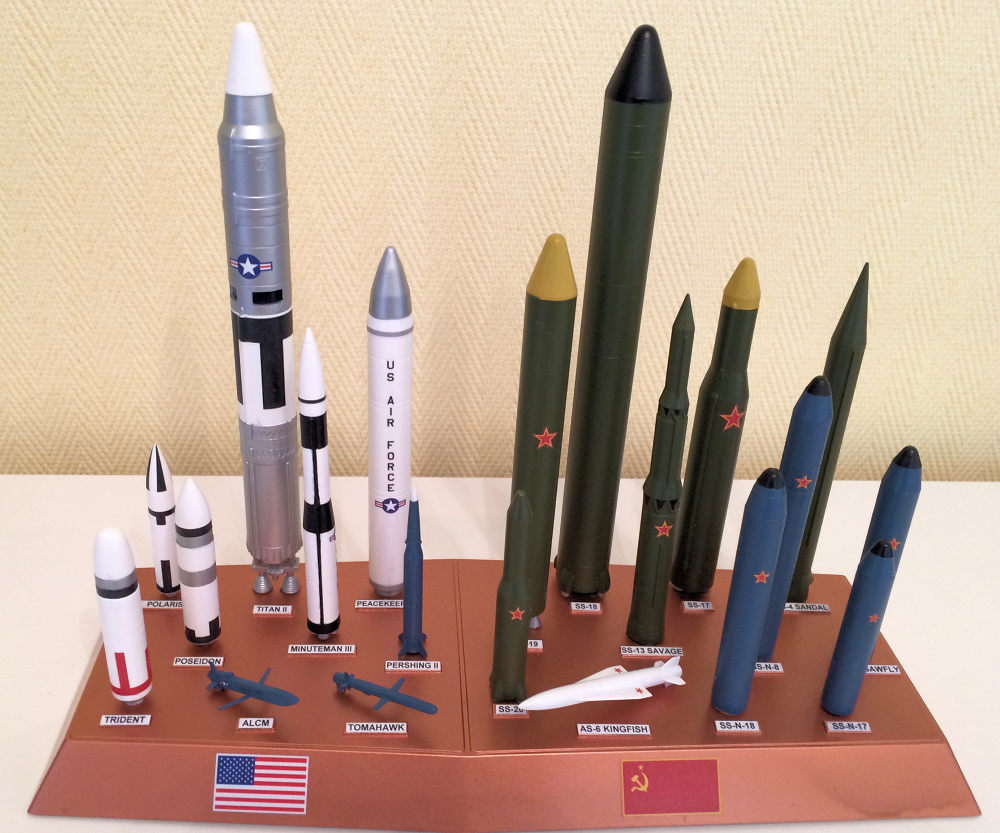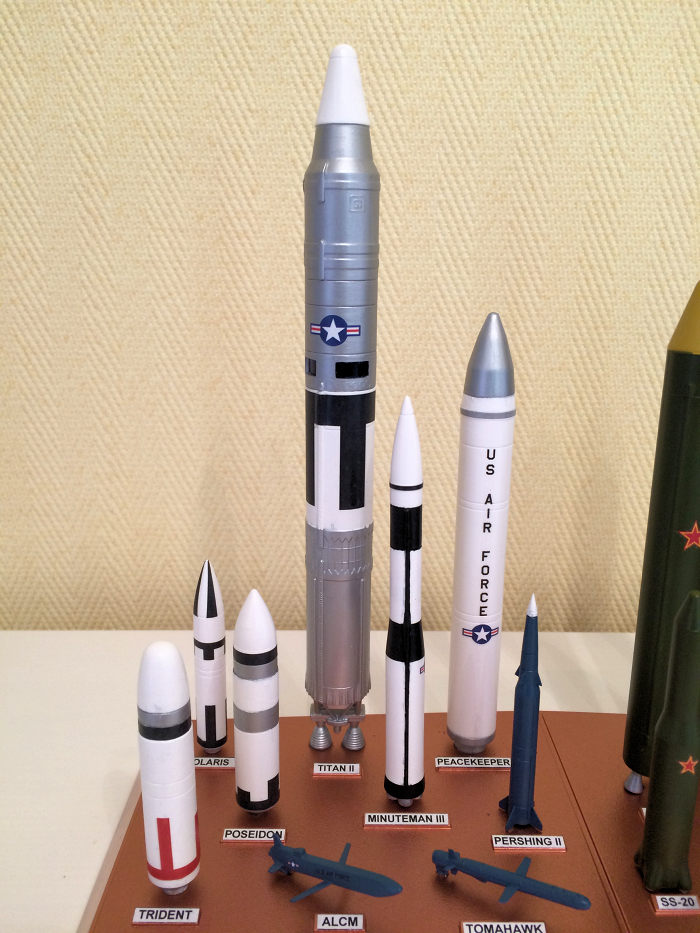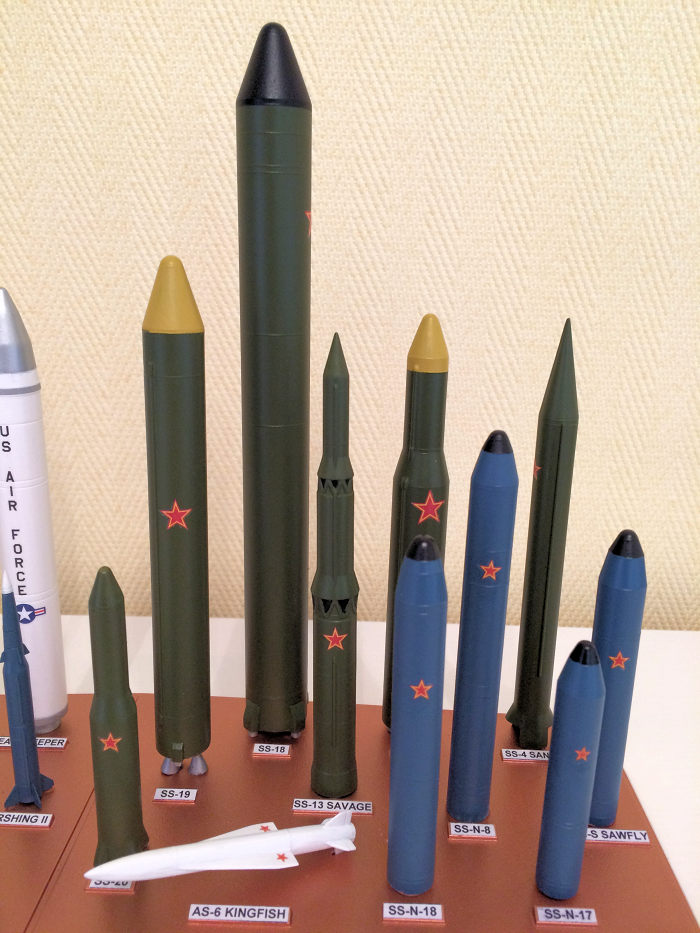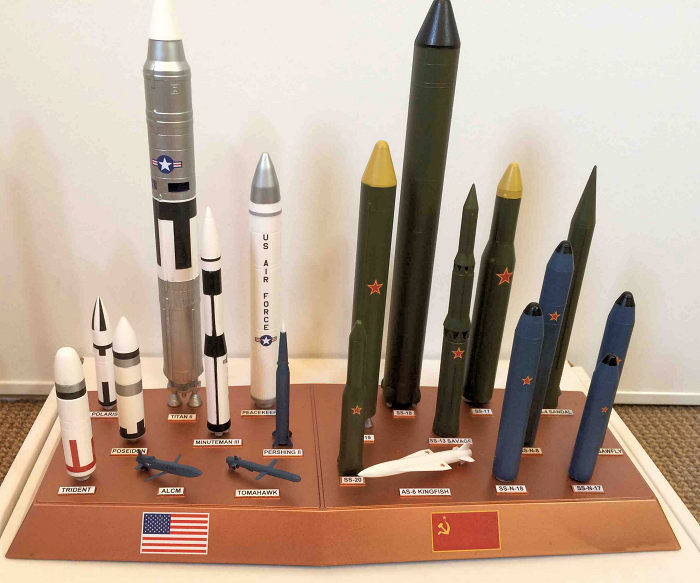
Monogram USA/USSR Missile Set
| KIT #: | 85-7860 |
| PRICE: | £30.00 or so |
| DECALS: | One option |
| REVIEWER: | Stephen Dearden |
| NOTES: |

| HISTORY |
A history of much of the military hardware of the Cold War can be considered in large part a history of missile development between the two main protagonists, the USA and the USSR. Since this review consists of 20 different missiles, only very brief descriptions of each missile will be provided in this section since we will be covering an overlapping group of 20 dependent histories in strategic missile development.
Titan II
The Titan II was the successor to the Titan I missile which was in use in the late 1950ís and early 60ís as the USAís first multistage Intercontinental Ballistic Missile (ICBM). When the Titan II replaced its predecessor, the designers doubled the payload capacity and more importantly switched from a liquid oxygen/RP-1 propellant combination to a storable propellant system of hydrazine and oxidiser. This allowed a Titan II to remain fully fuelled and provided rapid launch capability from an underground silo. A total of 54 Titan IIís were built and deployed with Strategic Air Command (SAC) squadrons in Arizona, Arkansas, California and Kansas.
Minuteman
In the late 1950ís, priority was given to liquid propellant ICBM development, but as time went by this was to be challenged. An important advocate of cheaper alternatives was USAF Colonel Edward N. Hall who, in the late 1950ís, oversaw solid fuel propulsion development at what is now the Space and Missiles Center of the Air Force Space Command in California. Hall considered liquid propellant missiles too complex, too large and bulky, and increasingly expensive. What was needed was a more compact missile with increased ease of manufacture, handling and transportability. The Minuteman programme was initiated to achieve these aims. Initially considered as a mobile weapon, this approach was rejected, and Minuteman missiles were deployed to the SACís increasing arsenal of silo sites scattered around the country. The Minuteman III missile is the current configuration and incorporates several improvements over its previous versions, principally related to the final stage and re-entry system used. First introduced in 1970, Minuteman III (also known as LGM-30G) is the current version and has been improved and modernized with life-extension programmes throughout its decades of service. As of 2016, the US Air force has plans to employ the missile until 2030 and it can certainly be considered, in view of its longevity and federal support, as probably one the most successful of the USAís strategic missile programmes. Much smaller than the Titan II, it stands at around 18m high and 1.8m in diameter.
Peacekeeper
The success and long operational lifespan of the Minuteman cast doubt on the need for a replacement, but chinks in the Minuteman armour began to appear as improvements in Soviet ICBM accuracy and power revealed vulnerabilities in the Minuteman system. Consequently, a new missile, named initially as the MX (for Missile eXperimental) and later to be called Peacekeeper, began development in real terms in the 1970ís, although it wasnít until 1986 before the first missiles were actually operational. In fact, the MX programme could trace its early plans and ideas back to the 1960ís. The Peacekeeper was a MIRV (Multiple Independently Targetable Re-entry Vehicle) missile, that could carry up to 10 re-entry vehicles, designed to counterattack the U.S.S.R. after a Soviet first strike with ICBMís. The first deployments were in converted Minuteman silos in Nebraska and Wyoming. A USAF proposal known as the Peacekeeper Rail Garrison was considered for a time as a mobile missile system to be deployed on the USAís national rail network to avoid being destroyed during a first strike, but this plan was cancelled following defence cutbacks at the end of the Cold War.
Pershing II
Development for an updated Pershing missile began in 1973 to replace the earlier version of the missile (Pershing Ia) because it was judged to be too powerful a warhead! This ballistic missile was to be fired in support of ground forces in a tactical Quick Reaction Alert (QRA) role. It was a 2-stage solid propellant weapon that was mounted on wheeled launch vehicles. The earlier version (Pershing Ia) had a 400 kt warhead which was reduced to variable yield warheads from 5 to 50 kt which were integrated in MARVs (Manoeuvrable Re-entry Vehicles). Pershing IIís were deployed with the US Army as a nuclear capable theatre weapon and the earlier Type-Ia versions were deployed with NATO forces in Germany. Following ratification and signature of the INF (Intermediate Range Nuclear Forces) treaty by Gorbachev and Reagan in 1987, Pershing Iaís and IIís were withdrawn from service in 1988 and subsequently all were destroyed by 1991.
 Polaris
A-3
Polaris
A-3
The Polaris concept was a remarkable R&D programme initiated by the US Navy in the late 1950ís to develop and deploy ballistic missiles that could be launched from submerged submarines. Polaris was a 2-stage nuclear armed missile built during the Cold War by Lockheed Corporation for the US Navy. It was designed to replace the Navyís Regulus cruise missile which had the drawback that the carrier submarine had to surface before a launch could take place. Polaris, on the other hand, could be launched underwater. The missile employed solid propellants to avoid the use of dangerous liquid fuels aboard ship. Its strategic role was to complement the limited number of medium-range missile systems that were deployed throughout Europe in the 1960ís.
Poseidon
After Polaris came Poseidon, the US Navyís second nuclear-armed, submarine-launched ballistic missile (SLBM), becoming operational in the early 1970ís. Although larger and significantly wider than Polaris, the Poseidon missile was still operational on Polaris submarines when it was found possible to remove the liner and locating rings from the subís launch tubes. Poseidon possessed a completely new inertial guidance system, carried twice the payload of Polaris and had improved targeting accuracy since guidance information was continuously updated by the subís navigation system as the submarine changed position.
Trident
Trident was the natural successor to Poseidon for the US Navy, who had begun studying the design in the early 1970ís. The programme objectives were to double the range of Poseidon and make improvements to propulsion, guidance and payload. To improve aerodynamic stability after launch, the missile incorporated a long probe, called an aerospike, that extended from the nose after launch. The guidance system also included a star-sighting system in addition to the usual inertial guidance, to make small corrections to trajectory and improve accuracy. The missile was deployed in the larger Ohio Class of U.S. submarines.
ALCM
An ALCM is a generic name for an air-launched cruise missile of which there are several variants developed over the years by the USAF and other air forces. Essentially a small pilotless aircraft, an ALCM is fired from the air by a heavy bomber such as the B-52 or B-1B. Provided with tail fins and an engine air intake, stubby retracted wings opened after launch from the air and the missile cruised to its target. Compared to conventional air-to-surface missiles, cruise missiles are larger and much slower. However, they have a much greater range, allowing the launch aircraft to stay away from the target at distances up to 1600 km.
Tomahawk
The Tomahawk missile is the US Navyís version of a cruise missile, usually launched at sea, but can in fact be launched from land or air and as such can be considered the most versatile missile in the world. The two main types are the land-attack and the anti-ship versions.
SS-4 Sandal
Known as the R-12 in the former Soviet Union, this was the theatre ballistic missile that Khrushchev deployed in Cuba and that led to the Cuban Missile Crisis in 1962. It was the first Soviet missile to employ storable liquid propellants. The missile required a launch crew of about 20 personnel to erect and prepare the weapon. Well over 2000 were manufactured during the Cold War. All were destroyed by 1993 under the US and Soviet Arms Control Treaty.
SS-13 Savage
The RT-2 was a Soviet ICBM with the NATO codename Savage in the West. It was the first large Soviet missile to use a solid propellant and was approximately the same size as the Minuteman. Around 60 were built and entered service, before further development was haltered.
SS-17
The SS-17 was an ICBM with a MIRV carrying 4 nuclear warheads. Developed as a replacement for the aging SS-11, it was installed in the same silos as the SS-11 and was the first Soviet missile to employ ďcold-launch ejectionĒ whereby the missile was ejected from the silo by a powerful gas generator and the first stage was ignited only when the missile was well above ground. This was done to minimize blast damage to the silo and somewhat increased the range of the missile.
SS-18
Developed through 6 modifications with various multiple warheads and yields up to 1Mt, the SS-18 was generally regarded as the largest missile in the world. With its high accuracy and powerful warheads, the SS-18, with an appropriate NATO designation of Satan, largely negated the efforts of protective hardening of U.S. missile sites that rendered for the whole U.S. Minuteman missile force vulnerable to attack. Over 300 launch silos were operational before the fall of the Soviet Union in 1991. The Russian Federation has steadily reduced the number of SS-18s and as of 2013 only 55 operational missiles remain.
SS-19
NATO-codenamed Stiletto, the SS-19 was developed concurrently with the SS-17. It was considered in the West to be less advanced technically, but still able to get similar results as it carried 6 independently targetable warheads. Around 300 missiles were operational and deployed in Russia and the Ukraine. Following the signature of the START I Treaty in 1991, the Ukraine has dismantled both missiles and launchers. As of 2017, 30 silo-based missiles are still deployed with the Russian Federationís 60th Rocket Division.
SS-20
Codenamed by NATO as the SS-20 Saber, this was an intermediate range ballistic missile known as the RSD-10 Pioneer in the U.S.S.R. It was based on two solid-fuel propellant stages and it is estimated that the final version of the missile had a range of approximately 7,500 km. The missile was fired from a mobile transporter/launcher and carried 3 highly accurate warheads. Between 300-400 launchers were deployed in the late 1970ís.
 SS-N-6
SS-N-6
Incorrectly labelled as the Sawfly in Monogramís kit instructions, the correct NATO reporting name is the SS-N-6 Serb. This missile could be gas-ejected from the 16 launch tubes of a Soviet Y-class (Yankee Class) nuclear powered submarine and a total of 34 subs were commissioned, deploying well over 500 missiles. The Serb had 3 warheads, but sufficient accuracy and power were lacking, and it was thought to be largely ineffective against hardened US missile silos.
SS-N-8
The R-29 Vysota is a family of Soviet SLBMís with different dimensions, payload capacity and range. The basic version was given the NATO reporting codename Sawfly and was considered the most important missile in the Soviet Navy. At the time it was operational, it had a greater range than any other SLBM and so posed a serious threat to the West. It was thought to be a 2-stage missile using liquid fuels and a combination of stellar and inertial guidance systems. The Sawfly was significantly larger than its SS-N-6 predecessor and could only be deployed on much larger Delta-Class Soviet submarines.
SS-N-17
This missile, called the R-31 in the U.S.S.R, was codenamed the Snipe in the NATO reporting scheme. It was thought to be the first Soviet SLBM to use solid propellants and was fitted to Yankee-Class Soviet submarines. It was armed with a single 500kt nuclear warhead but had a relatively short service life, being decommissioned in 1991.
SS-N-18
A member of the R-29 class of SLBMs, the SS-N-18 was designated the Stingray and was fitted on Soviet Delta-Class submarines. It was first tested in the 1970ís. Each missile carried 2 independently targetable warheads and it was propelled with liquid fuel.
AS-6 Kingfish
Developed in land-attack and anti-ship roles the KSR-5, as it was called in the U.S.S.R, was an air-launched cruise missile carried by the Soviet Tupolev Tu-16 Badger and Tu-22 Backfire strategic bombers. The missile could be armed with either a conventional or nuclear warhead and had a range of from 300 to 700 km, dependent on cruising altitude.
| THE KIT |
The missile set comes in a standard Monogram box with a top lid (Iím not a big fan of those side-opening boxes that we see nowadays). All missile components are on two full length sprues in white plastic, together with a large moulded presentation base for showing off the set.
There is a stapled instruction booklet in English, French and Spanish with a single section for each missile together with a few lines of history. There are 20 sections in all that cover each missile.
| CONSTRUCTION |
This certainly must be quite the simplest set of small models that I have ever built, and the reason is very simple: of the 20 different missiles represented in this set, with one exception (the SS-18) each missile consists of just two halves that require cementing together! Small wonder then that the skill level is rated only 2 by the folks at Monogram.
There are no ejector pin marks on the visible parts of the components and there is a wonderful, total absence of flash. Each half of the missile went together nicely with the small alignment pins fitting snuggly and seam lines were hardly visible, requiring only moderate sanding after gluing.
 I was
pleased that I decided to re-start my model making hobby with this very easy set
because I had not built any plastic kits for well over 45 years.
No, Iím not kidding you!
Now that I am well into my sixties I have kind of rediscovered my youth with
this stroll down nostalgia lane of model making.
I was
pleased that I decided to re-start my model making hobby with this very easy set
because I had not built any plastic kits for well over 45 years.
No, Iím not kidding you!
Now that I am well into my sixties I have kind of rediscovered my youth with
this stroll down nostalgia lane of model making.
For paints, I attempted to stick to the box colour scheme as much as possible. Vallejo acrylics were used for the most part. Although I recently invested in an air-brush (which is proof that I am serious about re-starting my hobby), I am, nevertheless, a total newbie when it comes to airbrushing. I will need a lot of practice spraying sheets of cardboard before I even dare to approach a real model kit. Consequently, I opted to spray the larger green Soviet SS missiles with Tamiya TS-28 Olive Drab straight from a can. This produced a nice smooth finish.
For the base, I wanted something brighter and more contrasting in colour than the boring ďbattleship greyĒ suggested by Monogram in their box art. So out came a spray can of gold satin lacquer obtained from my local hardware store. The only Ďdifficultí part of this build was painting the base properly: the missile nameplates are recessed in the mould and I was concerned about having to paint all these names neatly. So, to make things simple, and to avoid some potentially sloppy work hand-painting all the names of each missile in their tiny recesses, I used a laser printer to print the names in black and white using a printer font of the right size (achieved by trial and error). Then I cut out and glued the labels in place followed by a final coat of transparent semi-gloss from a can over the whole model set.
| CONCLUSIONS |
All in all, I am quite pleased with the result of my first attempt at model making after an absence that spans two generations! This is an extremely easy set of small models to build with each missile being of high mould quality. I can recommend it to modellers of all ages who have an interest in space-related kits and it reflects a fascinating period in our recent history during the Cold War. The finished set of missiles on the base is beautifully sized at 30cm wide, 12cm deep and 25cm high and fits nicely on any bookshelf or in a display case.
| REFERENCES |
To Defend and Deter: The Legacy of the United States Cold War Missile Program, U.S. Government, Department of Defense, U.S. Air Force, Progressive Management Publications.
April 2018
Copyright ModelingMadness.com
My sincere thanks to my own wallet, credit
card and a certain well-known bidding site for allowing me to construct this
set! If you would like your product reviewed fairly and fairly quickly, please contact the editor or see other details in the
Note to
Contributors. Back to the Main Page
Back to the Review
Index Page
Back to the Previews Index Page